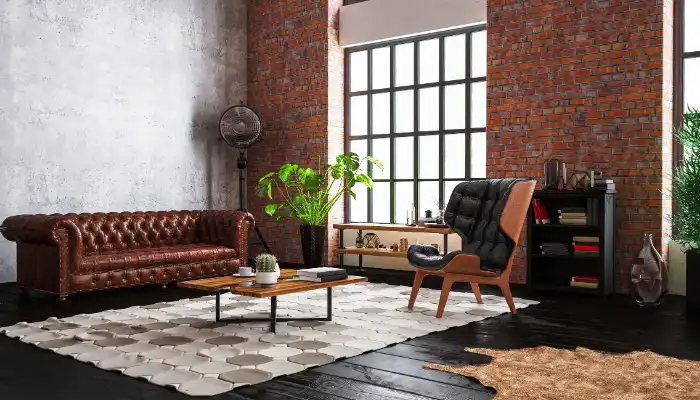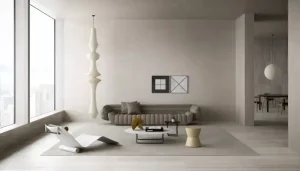Vintage furniture has transcended the realm of dusty attics and antique shops to reclaim its rightful place in contemporary home design. These pre-loved treasures, often crafted with meticulous attention to detail and boasting unique character, are gracing modern living spaces with a touch of timeless elegance and individuality.
But what exactly is driving this resurgence of vintage furniture, and why are homeowners opting for pieces steeped in history over mass-produced, modern counterparts? Let’s delve into the fascinating story behind vintage furniture’s comeback and explore the reasons why it’s here to stay.

A Walk Through Time: Understanding Vintage Furniture
Before we explore the reasons behind its revival, let’s establish a clear understanding of what constitutes “vintage” furniture. Generally, vintage furniture refers to pieces that are at least 20 years old, but not exceeding 100 years. These pieces often embody the design aesthetics and cultural influences of the era they were created in.
Table 1: Popular Vintage Furniture Styles and Periods
| Period (Estimated Age Range) | Style Characteristics | Examples |
|---|---|---|
| Mid-Century Modern (1940s-1960s) | Clean lines, functionality, focus on natural materials like wood and leather, organic shapes. | Tufted sofas, chrome and glass coffee tables, sculpted armchairs. |
| Art Deco (1920s-1930s) | Bold geometric patterns, luxurious materials like chrome, lacquer, and velvet, focus on symmetry and glamour. | Zigzag chairs, chrome and glass side tables, streamlined cocktail cabinets. |
| Victorian (1830s-1900s) | Ornate details, rich upholstery fabrics, dark wood tones, focus on comfort and craftsmanship. | Wingback armchairs, velvet sofas with rolled arms, elaborately carved dressers. |
Understanding the Shift in Modern Design Preferences
The resurgence of vintage furniture can’t be viewed in isolation. It’s intricately linked to a broader shift in design preferences within contemporary homes:
- Sustainability and Eco-Consciousness: A growing awareness of the environmental impact of mass production has led many homeowners to embrace sustainable design practices. Vintage furniture embodies a “reduce, reuse, recycle” philosophy, offering a way to minimize environmental impact and extend the lifespan of beautiful pieces.
- Minimalism and Decluttering: The trend towards minimalism and decluttering has fostered an appreciation for clean lines, functionality, and unique statement pieces. Vintage furniture often ticks all these boxes, offering well-made pieces with timeless aesthetics that can seamlessly integrate into minimalist spaces.
- Uniqueness over Mass Production: Today’s homeowners are increasingly drawn to one-of-a-kind pieces that tell a story and reflect their individuality. Vintage furniture, with its inherent history and character, offers a stark contrast to the uniformity of mass-produced furniture, allowing homeowners to curate spaces that reflect their personal style.
- Social Media Influence: The rise of social media platforms like Instagram and Pinterest has significantly impacted design trends. Vintage aesthetics, often showcased by design bloggers and influencers, have captured the hearts of many, fueling the desire to incorporate these styles into their own homes.
The Enduring Allure of Vintage Furniture
Beyond the broader trends in design, vintage furniture offers a unique combination of qualities that resonate with modern homeowners:
- Appreciation for Quality Craftsmanship: Vintage furniture is often built to last, using high-quality materials and traditional joinery techniques that are rarely seen in today’s mass-produced pieces. These pieces offer a sense of durability and timeless elegance that is unmatched by modern counterparts.
- Individuality and Personal Expression: Vintage furniture allows homeowners to move beyond the cookie-cutter aesthetic of mass-produced furniture. Each piece possesses a unique history and character, allowing homeowners to curate spaces that reflect their personality and tell a story.
- The Nostalgia Factor: Vintage furniture often evokes a sense of nostalgia, reminding us of a bygone era. Owning and incorporating these pieces into your home can create a warm and inviting atmosphere, filled with cherished memories and a connection to the past.
- Design Trends and Influencers: Popular interior design trends often feature vintage furniture prominently. This exposure, coupled with the influence of design bloggers and social media personalities, has undeniably contributed to the renewed appreciation for vintage pieces.
- Economic Advantages: Vintage furniture can be significantly more affordable than high-end, brand-new pieces. This affordability allows homeowners to acquire unique and well-made furniture without breaking the bank.
Advantages of Vintage Furniture
The appeal of vintage furniture goes far beyond mere aesthetics. Here are some compelling reasons to consider incorporating vintage pieces into your home:
- Timeless Appeal and Enduring Quality: Vintage furniture is often crafted from superior materials and built to last. Classic styles transcend fleeting trends, offering an elegance and sophistication that never goes out of fashion.
- Sustainability and Environmental Benefits: Choosing pre-loved furniture reduces your environmental footprint. It extends the lifespan of existing pieces and minimizes the need for new furniture production, which can have a significant impact on resource depletion and pollution.
- Versatility and Design Compatibility: Vintage furniture comes in a vast array of styles and periods. From mid-century modern to art deco, you can find vintage pieces that seamlessly integrate with various design aesthetics, adding a layer of visual interest and depth to your space.
- Investment Potential and Appreciation: Certain vintage furniture pieces can appreciate in value over time, making them a worthwhile investment. Think of a well-preserved mid-century credenza or a statement art deco armchair – these can become prized possessions that not only enhance your home but also hold potential financial value.
Table 1: Environmental Benefits of Choosing Vintage Furniture
| Benefit | Description |
|---|---|
| Reduced Resource Consumption: | Extends the lifespan of existing furniture, reducing the need for production of new furniture and associated resource extraction. |
| Minimized Waste: | Prevents usable furniture from ending up in landfills. |
| Lowered Carbon Footprint: | Reduces energy consumption and pollution associated with manufacturing new furniture. |
Challenges and Considerations
While vintage furniture offers undeniable advantages, there are a few challenges to navigate:
- Finding Authentic Pieces and Reputable Sellers: With the rising popularity of vintage furniture, it’s crucial to differentiate between genuine vintage pieces and reproductions. Research reputable sellers, like antique stores, vintage markets, or online platforms with established track records.
- Addressing Wear and Tear, Repairs, and Restoration: Vintage furniture may show signs of wear and tear. Consider the extent of damage and whether repairs or restoration are feasible and fit your budget. Imperfections can also add to the character and charm of vintage pieces.
- Integrating Vintage with Modern: Striking a balance between vintage and modern elements is key to a cohesive design. Consider the scale, proportion, and color palette of your existing decor. Vintage pieces can serve as focal points, while contemporary furniture can complement and balance the overall aesthetic.
- Budget Considerations: While some vintage finds can be surprisingly affordable, others can be pricier depending on style, era, and condition. Set a budget and prioritize pieces that resonate most with your needs and taste. Remember, vintage furniture is often an investment that can last for years to come.
Crafting a Vintage Vision: Tips for Successful Integration
Ready to embrace vintage in your home design? Here are some tips to guide you:
- Research and Define Your Style: Explore various vintage furniture styles from different eras. Identify what speaks to you, whether it’s the clean lines of mid-century modern or the ornate details of Victorian design.
- Mixing and Matching: Don’t be afraid to mix vintage pieces with contemporary furniture and decor. A vintage armchair paired with a modern sofa or a mid-century sideboard showcasing sleek modern accessories can create a dynamic and visually interesting space.
- Scale, Proportion, and Balance: Pay attention to the size and scale of vintage pieces in relation to your room layout. A bulky vintage dresser might overwhelm a small bedroom, while a delicate vintage side table could get lost in a large living room.
- Updating with Upholstery and Finishes: Consider reupholstering vintage furniture with new fabric to refresh its look and match your decor. Refinishing wooden pieces with a new stain or paint color can also breathe new life into a vintage find.
- Seek Inspiration: Get inspired by browsing design magazines, online platforms like Pinterest or Instagram, or visiting local antique shops and vintage markets. Observe how others incorporate vintage furniture and adapt those ideas to your own space.
Case Studies and Examples
To truly visualize the impact of vintage furniture in modern homes, let’s explore some real-life case studies and inspiring examples:
A. A Mid-Century Modern Oasis:
Imagine a light-filled living room with clean lines and pops of color. A sleek, walnut mid-century modern credenza serves as the focal point, displaying modern art prints and ceramics.
A vintage wingback armchair in a bold emerald green fabric offers a comfortable reading nook, while a plush, neutral-colored rug grounds the space. Modern floor lamps and minimalist coffee tables complete the look, creating a harmonious blend of vintage and modern aesthetics.
B. Art Deco Glam in the Kitchen:
Picture a chic kitchen featuring sleek white cabinetry and stainless steel appliances. A statement piece steals the show – a vintage art deco bar cart with mirrored shelves and chrome accents.
The homeowner uses it to display a collection of vintage cocktail glasses and art deco-inspired decanters. Modern bar stools with chrome frames complement the vintage piece, while pops of black through hardware and pendant lights tie the look together.
C. Before-and-After Transformation:
Witness the transformative power of vintage furniture! Before: a bland living room with generic furniture and uninspired decor. After: the same space comes alive with the introduction of a vintage Chesterfield sofa in rich brown leather.
A Moroccan-style rug adds a touch of texture and pattern, while a pair of mismatched vintage armchairs in contrasting fabrics creates a conversational area. Modern throw pillows and a statement coffee table with a metallic base complete the transformation, showcasing the ability of vintage pieces to elevate a space and inject personality.
D. Testimonials: The Voices of Vintage Enthusiasts
“Vintage furniture allows me to express my unique style in my home,” shares Sarah, a homeowner who loves incorporating mid-century modern pieces. “It adds a layer of history and conversation starters. Plus, the quality is often unmatched!”
David, an interior designer, emphasizes the sustainability aspect: “Vintage furniture is a much more eco-friendly choice compared to mass-produced furniture. It’s a win-win for style and the environment.”
Conclusion
The resurgence of vintage furniture is more than just a trend; it’s a testament to the enduring appeal and enduring quality of these pieces. By incorporating vintage furniture into your home design, you not only add a touch of timeless style and character but also make a sustainable choice.
So, embark on your vintage treasure hunt, explore the world of antique shops and flea markets, and discover unique pieces that will transform your home into a reflection of your personality and a celebration of design history. Remember, vintage furniture isn’t just about the past; it’s about weaving the past, present, and future together to create a truly captivating living space.


